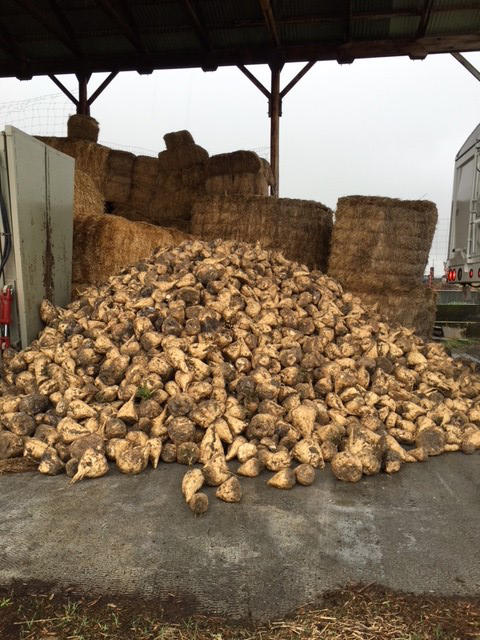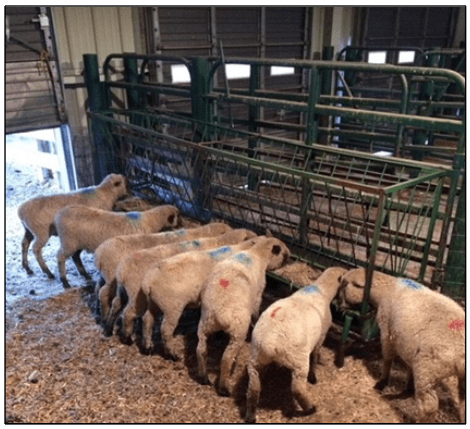Introduction
The Pacific Northwest is a major producer of sugar beets. Idaho was the second-largest producer of sugar beets in the United States in 2018, while Oregon was the 10th-largest producer. In some years, the supply of sugar beets may overwhelm the demand, resulting in tons of sugar beets going to waste. For example, 39,000 tons of sugar beets were left unharvested in the Pacific Northwest after the 2017–18 harvest, and 97,500 tons were left unharvested after the 2015–16 harvest. This surplus in sugar beets presents a great opportunity for livestock producers, as they may be able get sugar beets for minimal cost, if any, to feed to livestock.
When this opportunity arises, it would be useful to have a better understanding of how sugar beets behave metabolically, so livestock producers can reap maximum benefit from this unique feedstuff. With feed being the largest expense for most livestock operations, using sugar beets as feed during surplus years can save the livestock producer a lot of money, while maintaining or exceeding performance from their animals.
Effects of sugar beets on livestock performance
Perhaps some of the biggest questions weighing on a livestock producer’s mind when presented with a great deal on sugar beets are: Will my animals even eat sugar beets? Will my livestock be able to maintain or gain weight if I replace more traditional energy sources (corn, barley, oats, etc.) with sugar beets?
According to the body of existing scientific literature, the answer to both of those questions is yes. In terms of the palatability of sugar beets, many studies have observed that the intake of sugar beets compared to more traditional feedstuffs like barley and steam-flaked corn is similar. A study where cattle were given the choice among sweet, sour, bitter or salty diets demonstrated that cattle strongly prefer the sweet diet over the alternatives.
In terms of performance, research studies have shown that average daily gain was similar among cattle fed barley, steam-flaked corn and whole sugar beets. Livestock producers can rest assured that replacing traditional energy sources with sugar beets will not cause detrimental effects to the performance of their livestock.
However, as with most feedstuffs, there is a balance when determining how much sugar beets to include in the diet. Feeding too little sugar beets may result in a lack of noticeable effect on the rumen environment, and feeding too much sugar beets can lead to acidic rumen conditions that may interfere with the digestion and absorption of nutrients. Sugar beets are a unique feedstuff. Consider their unique characteristics to get the most out of their use.
Unique characteristics of sugar beets as a feedstuff
Water content
If you have ever handled sugar beets, you likely noticed that this commodity contains high moisture content (75%–80%; Table 1). This makes them much different than other, more traditional energy supplements, and might be of concern for some livestock managers.
| Feedstuff | Nutrient content | ||
|---|---|---|---|
| Dry matter | Crude protein | Total digestible nutrients* | |
| Barley grain | 89.7 | 12.8 | 84.1 |
| Sugar beet | 20.1 | 6.8 | 81 |
| Steam-flaked corn | 80.7 | 8.5 | 95 |
Adapted from Schafer & Larder (2008) and NRC (2000).
*Values listed on dry matter basis.
Generally, diets containing a high level of moisture will have a higher rate of passage through the digestive tract. This may lead to an overall decrease in digestibility of the diet, as rumen microbes will have less time to break down the various components of the dietary ration. In this scenario, livestock may have to eat slightly more to make up for the decrease in digestion, due to the increased rate of passage.
Although it is beneficial to be aware of this characteristic of high-moisture feeds, differences in digestibility when sugar beets replace barley or steam-flaked corn up to 45% in the total mixed ration have been insignificant. In addition to the effect of high-moisture rations on digestion, high-moisture feeds may impede dry matter intake.
It is possible that the extra weight in the rumen as a result of high-moisture feeds may activate stretch receptors in the rumen wall, causing the animal to stop eating if the concentration of the high-moisture feed is too high in the total mixed ration. A 2018 study observed a significant decrease in intake when sugar beets exceeded 30% of the total mixed ration.
Sugar versus starch
Sugar generates different metabolic patterns in the rumen when compared to starch. Perhaps one of the more profound effects of sugar is a rumen microbial environment that contains less protozoa. Protozoa are rumen microorganisms that predate on the beneficial bacteria that livestock require to digest various feed components.
These beneficial bacteria use plant proteins for bacterial reproduction. As a result, these bacteria contain 50% protein, and serve as a major protein source for ruminant livestock. The protein from these bacteria contain an ideal amino acid profile for meat and milk production.
Possibly due to the effect on protozoa, increased sugar in the diet has been associated with higher rumen microbial protein production, and higher utilization of the protein provided by the diet.
It has also been demonstrated numerous times that the sugar provided by sugar beets may lead to higher fiber digestibility. Replacing steam-flaked corn or barley with sugar beets, up to 40% in the diet, was observed to linearly increase fiber digestibility. In the rumen environment, acetate is a metabolic product of fiber-digesting bacteria, and proprionate is a metabolic product of concentrate/grain-digesting bacteria. Acetate production significantly increases when sugar beets replace feedstuffs like steam-flaked corn or barley in the diet, suggesting that sugar beets encourage the reproduction of fiber-digesting bacteria.
Fiber digestibility is important in a diet that contains low-quality forages that are high in fiber, whether if it is a fall or winter grazing scenario, or if livestock are receiving poor quality hay. In the plant cell, fiber encapsulates all of the useful nutrients (protein, energy, minerals, etc.), and rumen bacteria must penetrate the fiber to gain access to useful nutrients. By increasing fiber digestibility, ruminants are able to efficiently obtain more nutrients from low-quality forages.
While feeding sugar-based energy sources to livestock may have some metabolic benefits over feeding starch-based energy sources, negative effects on animal health and performance may be observed when sugar is fed in excess (or any high-energy feedstuff, for that matter). Feed sugar beets at a rate that is less than 40% of the dry matter of the total mixed ration. If fed in excess, the abundance of energy in the rumen may lead to an acidic environment. Acidic rumen environments support the reproduction of undesirable bacteria that produce lactic acid. An abundance of lactic acid in the rumen eventually leads to acidosis, which can kill an animal.
While metabolic benefits like enhanced microbial protein production and increased forage digestibility are observed when sugar beets are fed between 15%–40% of the dry matter of the total mixed ration, those benefits will soon disappear if sugar beets are fed in excess of 40%, and could lead to a fatal situation.
Implications for dairy operations
There has been some research on the implications of using sugar beets on dairy operations.
As previously mentioned, different bacteria produce different metabolic products as they digest feed components. In dairy operations, we are concerned with volatile fatty acids. Volatile fatty acids are a result of microbial metabolism of the energy provided by a ration, and they are a major source of energy for the ruminant animal.
The three major volatile fatty acids of concern are acetate, butyrate and propionate. These have their own unique effects on proportions of milk nutritional components; acetate and butyrate production in the rumen increases milk fat, and propionate increases milk protein. Acetate production is a result of bacteria that digest fibrous feeds, propionate production is a result of bacteria that digest energy concentrate feeds such as cereal grains, and butyrate production is a result of a combination of both fibrous and concentrate feeds.
The feeding of sugar beets has strongly been associated with an increase in acetate and butyrate production, and a decrease in propionate production. Therefore, sugar beets can be used to increase milk fat from dairy livestock, but may also result in a reduction of milk protein.
Processing for feed
You might ask yourself, “How in the world can an animal eat this thing?!” You might be surprised to learn that there have been some studies that involved grazing unharvested, unprocessed fodder beets, which has a physical form similar to sugar beets. Cattle will bite chunks out of these beets, similar to how humans eat an apple. Surprisingly, incidents of choking occur at very low rates, although it does still happen from time to time.
However, there are some issues with letting livestock eat whole, unprocessed sugar beets. Aside from the potential choking hazard, eating whole unprocessed sugar beets requires a lot of work and effort for livestock. Therefore, it is recommended that sugar beets be processed to a smaller particle size before feeding them to livestock.
Perhaps the easiest and most common method of processing used as part of the aforementioned studies is to run the beets through a wood chipper (Figure 2). However, wood chippers do cost money, and it might be difficult to justify this cost if the wood chipper is only being used to process sugar beets every now and then. An alternative is to spread the sugar beets on a very clean concrete pad, and run over them with your truck. Be sure that the concrete surface is free of small rocks, as those small rocks will cause accelerated wear on the teeth of your livestock.
It is also handy to have a water source nearby, whether you’re running the beets over with a truck or running them through a wood chipper, as processing sugar beets will create a sticky nightmare.
Storage options for sugar beets
Sugar beets are typically only available during harvest in late fall. This may lead to a situation where a livestock producer obtains quantities of sugar beets that are in excess of what can be used immediately. Storing sugar beets for a long period of time can be challenging due to their high moisture content.
Sugar beets will keep well over the winter, piled on a concrete pad, while outside ambient temperatures remain at or below 40°F. The main issue with this method is that deer and other wildlife may feed on the pile of sugar beets. Additionally, as temperatures rise, mold, degradation and bug infestations may occur. If the sugar beet supply will last past winter, research has demonstrated that sugar beets will keep well as silage.
The key to making good silage is putting feed in an anaerobic environment (where oxygen is absent), so that anaerobic bacteria can turn available energy into acid. This is important, as rapidly attaining a pH below 5 is the best way to inhibit the activity of enzymes that degrade the nutritional quality of the ensiled feed. The longer it takes for the pH to get below 5, the more useful nutrients are degraded.
Including sugar beets in a silage mixture actually significantly accelerates the rate of pH decline. A 2020 study demonstrated that including sugar beets in a silage mixture (50% hay, 50% sugar beets) maintained superior nutritional quality over a span of 180 days, compared to ensiling just hay by itself (Table 2). It is theorized that the water-soluble sugars that sugar beets provide allow anaerobic bacteria to convert that energy into acid much more rapidly than energy provided by other feed ingredients. For these anaerobic bacteria to do their job, it is important that oxygen is absent, and that the moisture content of the mixture be around 65%.
| Item1 | Day on ensiling | ||
|---|---|---|---|
| d 0 | d 90 | d 180 | |
| Hay | |||
| Dry matter | 34.81 | 33.07 | 33.46 |
| Crude protein3 | 9.63 | 9.99 | 9.92 |
| NDF2,3 | 61.78a | 63.39a | 69.26b |
| ADF2,4 | 44.98a | 49.03ab | 52.67b |
| pH | 6.20a | 4.77b | 4.77b |
| Sugar beets and soybean meal | |||
| Dry matter | 36.17 | 37.32 | 36.07 |
| Crude protein | 28.10a | 30.48b | 27.78a |
| NDF | 10.29a | 15.59b | 15.43b |
| ADF | 7.70a | 9.92b | 9.15ab |
| pH | 6.67a | 4.27b | 4.33b |
| Sugar beets and hay | |||
| Dry matter | 45.08 | 38.91 | 39.05 |
| Crude protein | 9.99a | 10.52b | 10.79b |
| NDF | 55.82a | 54.11a | 60.88b |
| ADF | 42.05a | 44.50b | 43.78ab |
| pH | 5.97a | 4.50b | 4.40b |
1Silage treatments were hay, sugar beets and soybean meal (mixed at rate of 50:50, dry matter basis); and sugar beets and hay (mixed at rate of 50:50, dry matter basis).
2Percentage on a dry matter basis
3Neutral detergent fiber
4Acid detergent fiber
a,bMeans without common superscript within row differ (P < 0.05)
Adapted from McGregor et al., (2020)
Conclusion
Surpluses of sugar beets can present some great opportunities for livestock producers. Livestock producers can get sugar beets for little to no cost in years where sugar beets are produced in surplus, and can use sugar beets to enhance protein utilization, fiber digestibility and milk fat concentrations. Sugar beets could prove to be useful when they are fed to livestock grazing low-quality forages, which could help extend the grazing season into the winter, or help cattle maintain performance when cool-season forages go dormant when temperatures rise during the peak of summer. Furthermore, sugar beets may help cattle efficiently obtain more nutrients out of low-quality supplemental hay.
Achieving the potential benefits of feeding sugar beets is not likely when sugar beets are just dumped in front of animals, with no regard for data that suggests that there is a balance. Data supports the conclusion that including sugar beets in the diet at concentrations of 15% of total dry matter or less will not decrease performance, but optimal levels of protein utilization of fiber digestibility as a result of feeding sugar beets may not be achieved.
On the other hand, decreased intake may occur when sugar beet concentrations exceed 30% of the total dry matter of a ration. Furthermore, as a viable energy source, it is possible that including sugar beets in the diet at a high rate may increase the risk of detrimental metabolic conditions like acidosis.
Achieving enhanced fiber digestibility might be tricky. Sugar beets should be fed with forage-based diets. It has been demonstrated that increased fiber intake leads to more fiber-digesting bacteria in the rumen. In every study where it was observed that fiber digestibility increases with sugar or sugar beet supplementation, fiber intake increased as sugar beets increased in the diet.
A 2018 study did not observe a linear increase in fiber digestibility like many other studies. The dietary treatments designed decreased chopped hay in the diet as sugar beet concentration increased in the diet. This led to a quadratic effect on fiber intake, where fiber intake was at its lowest when sugar beets were included at 15% and 30% of the ration, and highest when sugar beets were included at 0% and 45% of the diet. Fiber digestibility followed the same pattern, with fiber digestibility at its lowest when sugar beets were included at 15% and 30%, and at its highest when sugar beets were included at 0% and 45% of the diet. This goes to show that sugar beets are most appropriate for cattle receiving diets that are high in fiber.
With all of this information considered, it seems that optimal balance of protein utilization, fiber digestibility, and intake occurs when sugar beets are included at concentrations between 15% and 45% of the total dry matter of a forage-based ration. Sugar beets can also benefit livestock producers feeding a ration that does not contain high concentrations of forage-based fiber, as sugar beets will support similar performance as more traditional energy sources when included at concentrations less than 45% of the total dry matter of a ration, and sugar beets can be obtained at little to no cost in years where sugar beets are produced in surplus.
Resources
- Arrizon, A., R. Carrasco, J. Salinas-Chavira, M. Montano, N. Torrentera and R.A. Zinn (2012). Feeding value of dried shredded sugarbeets as a partial replacement for steam-flaked corn in finishing diets for feedlot cattle. Journal of Animal Science, 90(6), 1892–1897.
- Balch, C. C. (1950). Factors Affecting the Utilization of Food by Dairy Cows: 1. The Rate of Passage of Food through the Digestive Tract. British Journal of Nutrition, 4(4), 361–388.
- Belanche, A., M. Doreau, J.E. Edwards, J.M. Moorby, E. Pinloche and C.J. Newbold. (2012). Shifts in the rumen microbiota due to the type of carbohydrate and level of protein ingested by dairy cattle are associated with changes in rumen fermentation. The Journal of Nutrition, 142(9), 1684–1692.
- Bergman, E.N., R.S. Reid, M.G. Murray, J.M. Brockway and F.G. Whitelaw. (1965). Interconversions and production of volatile fatty acids in the sheep rumen. Biochemical Journal, 97(1), 53–58.
- Campling, R.C. and C.C. Balch. (1961). Factors affecting the voluntary intake of food by cows: 1. Preliminary observations on the effect, on the voluntary intake of hay, of changes in the amount of the reticulo-ruminal contents. British Journal of Nutrition, 15(4), 523–530.
- Chamberlain, D.G., P.C. Thomas, W. Wilson, C.J. Newbold and J.C. MacDonald. (1985). The effects of carbohydrate supplements on ruminal concentrations of ammonia in animals given diets of grass silage. The Journal of Agricultural Science, 104(2), 331–340.
- Gibbs, S.J. and B. Saldias (2014). Fodder beet in the New Zealand dairy industry. Proceedings of the South Island Dairy Event, 237–246.
- Huhtanen, P. (1988). The effects of barley, unmolassed sugar-beet pulp and molasses supplements on organic matter, nitrogen and fibre digestion in the rumen of cattle given a silage diet. Animal Feed Science and Technology, 20(4), 259--278.
- Lage, J.F., E.S. Vito, R.D.A. Reis, L.M. Delevatti, N.S. Pierre, and T.T. Berchielli. (2017). Ruminal fermentation of Nellore steers fed crude glycerine replacing starch vs. fibre-based energy ingredient in low or high concentrate diets. Acta Scientiarum. Animal Sciences, 39(1), 57-64.
- Lana, R.P., J.B. Russell and M.E. Van Amburgh. (1998). The role of pH in regulating ruminal methane and ammonia production. Journal of Animal Science, 76(8), 2190-2196.
- McGregor, I., C. Page, W. Stewart and M. Van Emon. (2018). Effects of Sugar Beets on Steer Backgrounding Performance, Sheep Nutrient Metabolism, and Rumen Fermentation Characteristics. Journal of Agricultural Studies, 6(3), 190-205.
- McGregor, I., J.G.P. Bowman, C.M. Page, A.R. Hubbard, M. Manoukian, W.C. Stewart and M.L. Van Emon. (2020). The Effect of Ensiling Sugar Beets on Preservation Characteristics, Nutrient Profile, and in Situ Disappearance. Journal of Agricultural Studies, [S.l.], v. 8, n. 4, p. 44-55, july 2020. ISSN 2166-0379.
- Moran, J. (2005). How the rumen works. Tropical dairy farming. Landlinks Press, Collingwood, VIC, Australia, 41-49.
- Morrison, F.B. (1936). Feeds and feeding. Soil Science, 42(5), 395-396.
- Nocek, J.E., and J. Russell. (1988). Protein and energy as an integrated system. Relationship of ruminal protein and carbohydrate availability to microbial synthesis and milk production. Journal of Dairy Science, 71(8), 2070-2107.
- Nombekela, S.W., M.R. Murphy, H.W. Gonyou and J.I. Marden. (1994). Dietary Preferences in Early Lactation Cows as Affected by Primary Tastes and Some Common Feed Flavors. Journal of Dairy Science, 77(8), 2393-2399.
- NRC. 2000. Nutrient requirements of beef cattle. 7th rev. ed. Natl. Acad. Press, Washington, DC.
- Oude Elferink, S.J.W.H., F. Driehuis, J.C. Gottschal and S.F. Spoelstra. (2000). Silage fermentation processes and their manipulation. FAO Plant Production and Protection Papers, 17–30. Rook, J.A.F., and C.C. Balch (1961). The effects of intraruminal infusions of acetic, propionic and butyric acids on the yield and composition of the milk of the cow. British Journal of Nutrition, 15(3), 361-369.
- Rooke, J.A., C. Rymer, F.M. Maya and D.G. Armstrong. (1992). Effect of including barley or molassed sugar beet feed in grass silage diets on their digestion by cattle and sheep. Journal of the Science of Food and Agriculture, 58(4), 475-483.
- Schafer, R. and G. Lardy. (2008). Feeding Sugar Beet Byproducts to Cattle. NDSU Extension Service. AS-1365.
- Smith, S.B. and J.D. Crouse. (1984). Relative contributions of acetate, lactate and glucose to lipogenesis in bovine intramuscular and subcutaneous adipose tissue. The Journal of Nutrition, 114(4), 792-800.
- Van Houtert, M.F.J. (1993). The production and metabolism of volatile fatty acids by ruminants fed roughages: A review. Animal Feed Science and Technology, 43(3-4), 189-225.
- Voelker, J.A. and M.S. Allen. (2003). Pelleted beet pulp substituted for high-moisture corn: 3. Effects on ruminal fermentation, pH, and microbial protein efficiency in lactating dairy cows. Journal of Dairy Science, 86(11), 3562-3570.
- USDA. 2019a. Idaho State Agriculture Overview. (Accessed 13 July 2020).
- USDA. 2019b. Oregon Annual Statistical Bulletin. (Accessed 13 July 2020).
- USDA. 2019c. Idaho Annual Statistical Bulletin. (Accessed 13 July 2020).
- USDA. 2020. U.S. sugarbeet crops: area planted, acres harvested, yield per acre, and production, by state and region. Table 14. (Accessed 13 July 2020).



